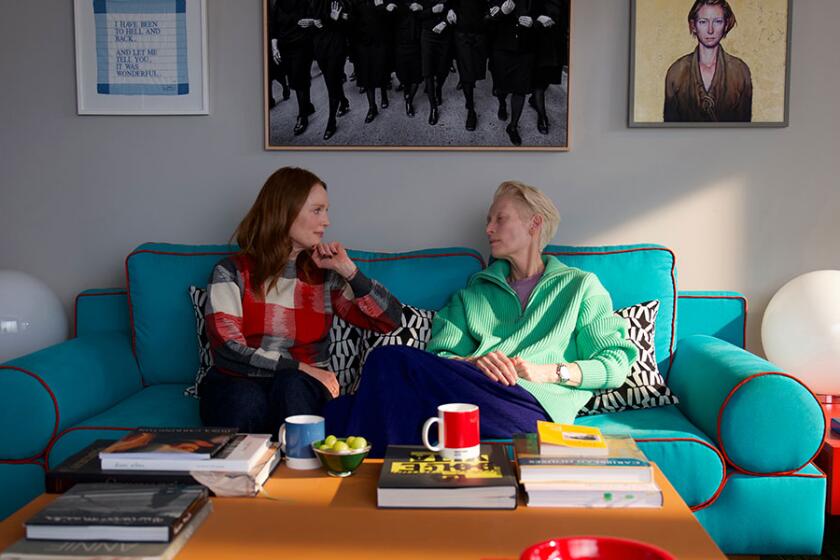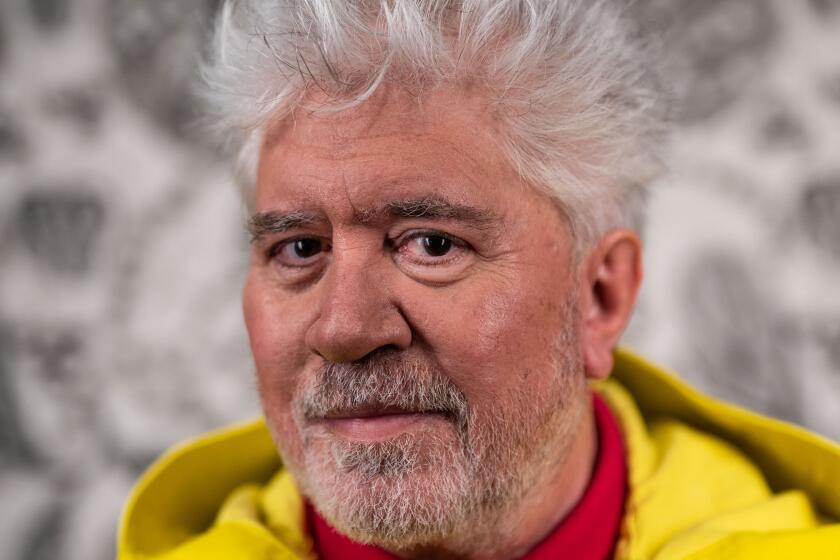
While Pedro Almodóvar was making “The Room Next Door,” a film very much concerned with mortality and what comes after this life, the 75-year-old Spanish director started noticing something otherworldly occurring. “We were shooting in this house in the woods,” he recalls, “and I felt very clearly that we were four — it was Tilda, Julianne, me and the dead. We were living together.”
Speaking over Zoom from Madrid, the stylish filmmaker is blasé about the memory of this spectral presence. “It was not creepy,” Almodóvar says matter-of-factly. “It was completely natural.”
That acceptance of the unknowable infuses “The Room Next Door,” Almodóvar’s first English-language feature, which won the Golden Lion at the Venice Film Festival and is one of his most melancholy yet quietly hopeful works. Starring Tilda Swinton as Martha, a war reporter with terminal cancer, and Julianne Moore as Ingrid, a novelist who has lost touch with her old friend over the years, this New York-set drama is powered by an unusual proposal Martha makes to her colleague. Unable to bear another round of chemo, Martha asks Ingrid to accompany her to a lovely rental house upstate, where she plans to die by taking a euthanasia pill. Initially, Ingrid resists, fearful that she lacks the emotional fortitude to be there for Martha, but once she acquiesces, they grow closer during their bittersweet getaway.
When Almodóvar read Sigrid Nunez’s 2020 novel “What Are You Going Through,” on which his film is based, he was intrigued by this dying character’s request. “I thought it was a good seed to develop into something bigger,” he says. Almodóvar eventually put the book aside to dream up his own story, although he retained a side character — a fatalist (played by John Turturro), who believes our species is doomed due to global warming. “It was important telling the story of someone that is dying in a world that is also dying,” Almodóvar says. “Living in this painful moment, you should find the moments to celebrate life.”
He understands such pain, both existential and physical. In recent years, Almodóvar has battled chronic back issues, which spurred his 2019 Oscar-nominated, semiautobiographical feature “Pain and Glory,” about an older director (longtime collaborator Antonio Banderas) fighting myriad ailments.
He immediately knew who needed to play the two leads in “The Room Next Door.” “Before I started writing, I thought of Tilda, because the relationship between us in ‘The Human Voice’ was wonderful,” he says, referring to the 2020 short he made with her. “She belongs to a new species that is not human — a superior species. Then I thought immediately [of] Julianne, an incredible actress. I wanted someone less ‘spectacular’ than Tilda. Julianne has a quality — she’s a woman that could potentially go unnoticed. She can be a housewife, she can be a writer, she can be a president. I wanted someone that you would not, at first, maybe think much of them — they don’t call attention to themselves — but then as the film moves forward, you start to notice that she is very courageous. Julianne can look very ordinary or she can be very gorgeous.”

Cast against type, Julianne Moore and Tilda Swinton excel as old colleagues who get back in touch after a cancer diagnosis spurs them to take a morbid getaway.
Almodóvar positions Martha and Ingrid as differing ways of looking at death’s inevitability. Martha is ready to die, no regrets, while Ingrid (whose new novel dissects her inability to face death) wonders how her friend can be so willing to go. “I was much closer to Ingrid than to Martha,” he says of his own worldview. “I do not accept death. I am an atheist; I don’t have the support that religion gives you to believe in life after death. I also don’t believe in reincarnation. But the part where I identify with Tilda’s character is when she’s talking about sexuality. She says, ‘When I can’t sleep, I just think of all the men that I’ve slept with, even if it’s just been once.’ She says sex is the best way to fight against fear, against death.”
The right to die is controversial in America — euthanasia is legal in only 10 states, and Washington, D.C. — but euthanasia and assisted suicide are permitted in Spain. Almodóvar’s film is emphatic about the beauty of existence, but he argues that the freedom to end one’s life is a human right.
“I believe very strongly that a human being should be the owner of their own life,” he says, “just like they should be the owner of their own death — and, really, the owner of death only when all that life is giving you is unbearable pain. Obviously, this idea goes against what most religions believe. But what I want for people who are against euthanasia to think is that when they deny somebody the right to take their own life — especially if they are in a terminal situation — they’re condemning that person to live in pain.”

“I believe very strongly that a human being should be the owner of their own life,” he says, “just like they should be the owner of their own death — and, really, the owner of death only when all that life is giving you is unbearable pain.”
— Pedro Almodóvar
In one of his film’s most moving segments, Martha and Ingrid spend an evening watching “The Dead,” celebrated director John Huston’s swan song, based on James Joyce’s haunting story about the impermanence of everything. That film has great meaning for Almodóvar. “I love the movie,” he says. “It is one of the only examples where, someone so big like John Huston, the last movie was one of his best. Usually the last movie, they are not the best — but in this case, it’s completely exceptional.”
As Almodóvar talks about “The Dead,” however, it becomes apparent that his appreciation goes beyond the filmmaking. Huston died in August 1987 at the age of 81. “The Dead” was released four months later.
Pedro Almodóvar’s first book consists of a mix of short stories and personal essays that amount to ‘a fragmentary autobiography.’
“I remember when they were shooting,” seeing a photograph of Huston “in a wheelchair connected to an oxygen tank,” Almodóvar says. “He was sick, and he was working, and the face was a face of happiness, of doing what he really wants to do.” He has never forgotten that photo. “I remember very well that moment — I thought that I would like to end my life like this,” he says. “I didn’t mind to be sick if I’m doing what [I love]. I can be sick — that is not so difficult — but what is difficult is to make a masterpiece at the same time. That was a model for me.”
More to Read
From the Oscars to the Emmys.
Get the Envelope newsletter for exclusive awards season coverage, behind-the-scenes stories from the Envelope podcast and columnist Glenn Whipp’s must-read analysis.
You may occasionally receive promotional content from the Los Angeles Times.












